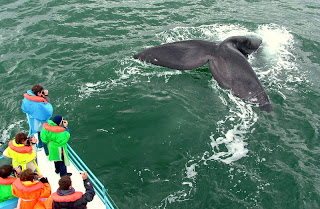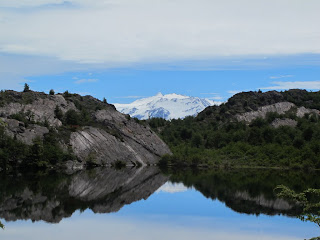 Torres
del Paine is a trekker’s dream. Anyone who takes this activity seriously knows
about the beautiful lakes, razor sharp gorges and amazing glaciers that make up this national park. But of course amateur trekkers like us also go
there. We covered 1500km in a day with a flight from Puerto Montt to Punta Arenas and a bus to Puerto Natales. We're going on the big “W”. And with places having names such as Valle del Silencio (Silence Valley), Cerro Catedral (Cathedral Peak), Aleta de Tiburón (Shark's Fin), Fortaleza (Fortress), La Espada (The Sword) or La Hoja (The Blade), we're really curious.
Torres
del Paine is a trekker’s dream. Anyone who takes this activity seriously knows
about the beautiful lakes, razor sharp gorges and amazing glaciers that make up this national park. But of course amateur trekkers like us also go
there. We covered 1500km in a day with a flight from Puerto Montt to Punta Arenas and a bus to Puerto Natales. We're going on the big “W”. And with places having names such as Valle del Silencio (Silence Valley), Cerro Catedral (Cathedral Peak), Aleta de Tiburón (Shark's Fin), Fortaleza (Fortress), La Espada (The Sword) or La Hoja (The Blade), we're really curious.
We
stayed at the “Tin House Hostel” which was a super cosy place. Laura came to
Chile 4 years ago from Texas to teach English and sure enough she met David who is
from this town. They got married and opened the hostel. What's great about this place is that it actually feels like a home rather than a
hostel. Firstly instead of being a bit of an industrial type
building it’s actually a house converted into a hostel so it has a
very nice living room and a fully equipped* kitchen with dining table, low yellow
(warmer) lights and wooden plinths and furniture.
(* not seen a dishwasher so far in S.A).
Secondly
Laura and David really go the extra mile to make you feel comfortable. They
make a great breakfast, they are ready to help in any way possible (booking tickets, laundry, calling to find out stuff) and they
are full of very useful and trustworthy advice when prompted. Laura has the foreigner perspective and David is a
mountain guide so he speaks about the "W" from experience.
 |
| Huge icebergs detached from Glacier Grey |
We attended the 3pm information session at Erratic Rock Hostel. It was
a great idea to do that. Koen (Dutch guy) gave a very comprehensive 1.5hrs long presentation and happily took questions at any moment. On top of clearly being a passionate and being very knowledgeable, he made it fun, which kept all 30 listeners hung to his lips till the end. And oh yeah, they serve coffee and tea before the talk. We advise people considering to trek to attend this session.
So
back to the actual trek. The “W” is the nickname given the trek most commonly done in Torres del Paine simply because the path you take describes a “W”. Most people do it in 4 nights / 5 days. Some people link the two open ends of the
“W” by walking 3 extra days behind the mountain formation. There are others who
decide to do the “W” in only 4 days but that adds quite a few hours of walking
to the remaining days. Since we are not "these people" we stuck to the first
option.
We
had also already decided not to camp and therefore not carry any additional cooking
equipment such a gas bottle, pans, cutlery and plates. We had already booked
the lodges (refugios) and meals. The only thing we still needed to decide upon was
whether to bring some walking poles and waterproof pants or not. We had gone into town
to look for equipment to rent the day before. Renting the poles seemed a bit expensive
(2500 Pesos/ US$5 per pole per day). Gloves and hats obviously had to be bought.
After the talk we decided not to take anything extra with us and go with the hats and gloves we already had.
We did take a trip to the supermarket to buy biscuits, dried fruits&nuts and chocolate. I even got myself 5 different
flavours of powdered juices. These are big in South America. You simply add a
small packet of powdered juice to 1L of water and voilà! Since water is drinkable and readily
available in the park I knew I would not have any problems shaking up these
juices.
 |
| The promise of astounding scenery |
Back
home we packed a big backpack and a small day pack. We brought some medical
supplies: Rhinofebryl, Iso-Betadine, sewing needle in case of cut skin
injuries, gauze, etc. We also brought our Swiss knife, a lighter, a compass, our head lamps, the iPods, the camera, the mobile phones + all the chargers. My bag probably weighed 11kg and Roxana's 9kg.
Day 1: Paine Grande to Refugio Grey (16.5km - 4h20min of walking)
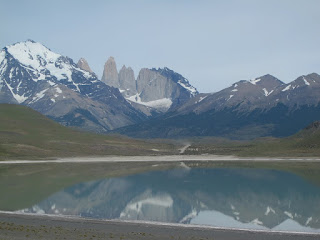 |
| Close to Pudeto entrance |
The
following morning the bus picked us up at 7.30a.m. to bring us to the entrance of
the park. It’s a 2.5hrs drive and the last hour is already spectacular. We got
off at the second stop (Pudeto) and took a catamaran to cross the lake and start
the trek at Refugio Paine Grande. We walked up a little over 4hrs to Refugio Grey where
we could see the Glacier Grey. This was brillant. That’s a whole glacier running
down from the mountains several dozens of metres thick. It’s the first time
I’m actually seeing a glacier, impressive. That night we finish the sandwiches
we brought with us and go to bed ready for a long next day.
 |
| Glacier Grey |
Day 2: Refugio Grey to Refugio Paine Grande (16.7km - 6h10min of walking)
 |
| Lunch with a view |
We
get up, have a big breakfast, pack our bags and go. We’re not going straight back down. First we head up towards the
glacier to see it from closer. About midway we meet Maibritt and Niels who were
camping 1.5hrs higher than us in a camping site. They tell us that it’s not
worth going all the way up. We decide to turn around and go to camp for the night in Paine Grande. We walk the next 4 hours in the company of this
very nice Danish couple. When we get there we actually ask to cancel one set of
dinner/breakfast/lunch-pack as the portions are enormous and one will suffice
for both of us.
 |
| Dribbling and swerving |
Niels and Maibritt continue on to “Campamiento Los Italianos”
2.5hrs away where they will camp. In the meantime a football game is about to
begin with some local people and I cannot resist. I undo the top eyelets of my
trekking boots to get some more ankle flexibility and we kick off. The game
goes on for just over one hour but that’s enough. We obviously win :-) and let's just say that according to football protocol I should have received 2 footballs from the ref and a magnum of champagne from the highest ranking official on site... the connoisseurs will understand what this mean!
Day 3: Refugio Paine Grande to Refugio Los Cuernos (27.5km - 8h of walking)
 |
| The famous "Cuernos" |
The
following morning after yet another hearty breakfast we set out for our third
day. We want to see the “Cuernos” (horns). These are impressive rock formations
made of minerals of two distinctly different colours. The shape of the formation
and especially the pointed tops look like horns, hence the name. The walk is amazingly
beautiful and terrain is relatively flat : not more than 100 meters difference in elevation between start and finish. When we reach the Refugio that evening the
sun is shining and it feels very warm: the ozone layer in this part of the
world is very thin and the sun is felt more intensely.
 |
| It's "not that cold" |
All of a sudden I see another trekker coming back from the lake at the edge of
which this refuge lies. He assures me that the water is “not that cold” … from
his accent I can tell he’s Scandinavian. Should I go or not? Can I trust a "not that cold" from a guy who comes from a country so cold that literally hundreds of lakes and rivers freeze over in winter time? I decide
to go find out. I walk down to the lake in my swimming trunks and go in very
carefully…It’s cold! But not as cold as the lake in the French Alps with
Jean-Yves. Here it must be about 10°C. I manage to stay in over 6 minutes which
beats the 45 seconds in France.
 |
| Valle del Frances |
Day 4: Refugio Los Cuernos to Refugio Los Chilenos (22.8km - 8h15min of walking)
 |
| From L to R: Niels, Maibritt, us and Martin. |
The
following morning we set off after breakfast with Martin, a French guy living in Hong Kong and Niels and Maibritt. We have yet another long day to our last refugio. This is Patagonia, with 200 days of storm per year and winds that casually blow over 100 km/h. But so far we have been very lucky with the weather. We got some blue skies in the mornings and some clouds in the afternoon. And today is a gorgeous day. Bright sun, blue sky and almost no cloud. It's already warm and we cream up for protection!
 |
| Last view on the "Cuernos" |
We should walk "only" 14-15km to our refuge and see off Niels, Maibritt and Martin who will continue up another 3 km to their camping site. But we already decided we will leave our bags at our refuge and walk up with them to their camping site. The reason for this is that the following morning at 3 a.m. (!) we need to walk up that way (and further) in the dark to watch the sunrise at the famous Mirador of the Torres. From the camping site to the summit there will be reflectors which will be picked up by flashlights but from our refuge to the camping site it's a 1h15 walk in the pitch dark forest - so we better do some reconnaissance in anticipation of the following morning.
 |
| Spectacular views on the way |
So we go on our walk to the refuge and by the time we reach there, the weather is still splendid. So much so that not only do we accompany our friends up to their camp site but we also will attempt the full ascent this afternoon itself. After the camping site it's steep and we're in the open on a barren face of the mountain. Without the shelter of the forest, we are at the mercy of the wind. It's blowing only moderately strongly so that's a relief. I cannot imagine this ascent with a gale force wind whipping rain or snow in your face and up into your jacket from underneath.
 |
| Los Torres del Paine! |
When we reach the top we are amazed by what we see. The three towers rise 3 km straight up against an intense blue sky. In the foreground is a lake with a milky greyish green colour. It is amazing. The wind is picking up now but we soon find some cover behind some rocks the size of a minibus! Andre, Lorenzo and Raj, all three from Portugal are also up there enjoying the view. We take some pictures and then decide to walk back down. While going back down we meet Artur the fourth member of that lusophone group. He comes from Brazil. Artur points out that the sky's changing and so it is. Menacing grey clouds are coming this way. We hope we get back down home dry. And we do!
 |
| Follow the instructions! |
Despite adding 8.4km to this day trek, the climb to the Mirador de las Torres was completely worth it. But it's not over, we're back for more the following morning. That evening we go to sleep early and set our alarm clocks to 2.45 a.m.! We're lucky that out of the 6 people sleeping in our dorm, 5 are going up. So no worries about waking everybody else.
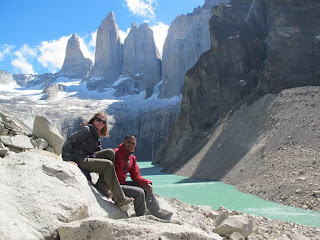
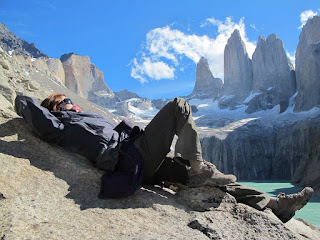
Day 5: Refugio Los Chilenos to Mirador Las Torres and down to Hospedia La Torre (13.1km - 4h15min of walking)
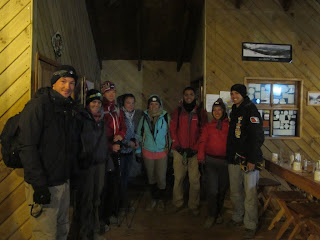 |
| The team of 8 going up |
The alarm rings at 2.45 a.m. and we get up and out of the room at once. We had already prepared everything beforehand and gear up. From the refuge we are a group of 8 going up. We end up leaving at 3.15 a.m. It's completely dark and the sky is filled with stars. Having done this the day before and looking for our way with 8 flashlights we find and follow the path with ease. We get to the camping site in 1 hour. From there we have 45 extra minutes and we are well in time.
 |
| Picture at 5.10am |
The day is breaking and it is lighter than we thought in the open. It's rather simple to follow the orange reflectors. When we get up there, only two other early birds beat us to it. It's 5.05 a.m. and the three towers offer a completely different but equally spectacular view. Soon more people arrive, including Niels and Maibritt. We had already arranged the day before that they would bring their gas stove and we water so we could cook tea up there. We get to it. It takes a long time because of the wind, but we manage. By the time the sun comes up, we each have a welcomed hot beverage in our hands. It's 5.39 a.m.
 |
| Picture at 5.45 a.m. |
The spectacle is truly magic. There is a certain mystery to these towers which is difficult to explain. It has to be witnessed. At around 6.30 a.m. we start our descent and reach our refuge a little before 8 a.m. We quickly wash up and sit intently in the eating area with the others who only just woke up. We've been awake and exercising for 5 hours and we are starving. The coffee, orange juice, toasts, porridge and scrambled eggs are gluttonously swallowed. We feel better and get our bags ready for the "final push". (and I don't mean the loo!).
Niels, Maibritt and Martin come down from their camping site at around 9.30 a.m. and we set off one hour later. It should be a piece of cake now: it's mostly downhill and only 1h15 long. After walking more than 80km over the last 4 days we are confident. But the wind who had been almost non-existent so far has decided to show us how hard walking in Patagonia can be.
It is blowing at about 70km/h with gusts going well over 100km/h. Its direction is changing all the time and because of the deep, steep gorges the wind sometimes seems to be coming straight up from underneath us. We are being bullied left and right by the wind. The gusts seem to be punching us in the face or at the back of our head. The extra surface area offered by our big backpacks is increasing the effect the wind has on us. Sometimes we are forced to stop, lie low and hold fast to a rock or branch if we are not to be blown off our feet and into the deadly precipice.
 |
| We are more relieved than tired |
We actually run down the last kilometre, pushed by the wind. We reach the luxurious resort at the entrance of the park and enjoy a big cold beer to celebrate the end of this 5 day adventure. We walked about 97 kilometres and had near perfect weather conditions all the way. And we made it without a scratch! That evening after a long hot shower and a good shave (for me), we meet up with Niels and Maibritt and enjoy a huge burger and in-house brewed dark ale at Baguales restaurant in Puerto Natales.

